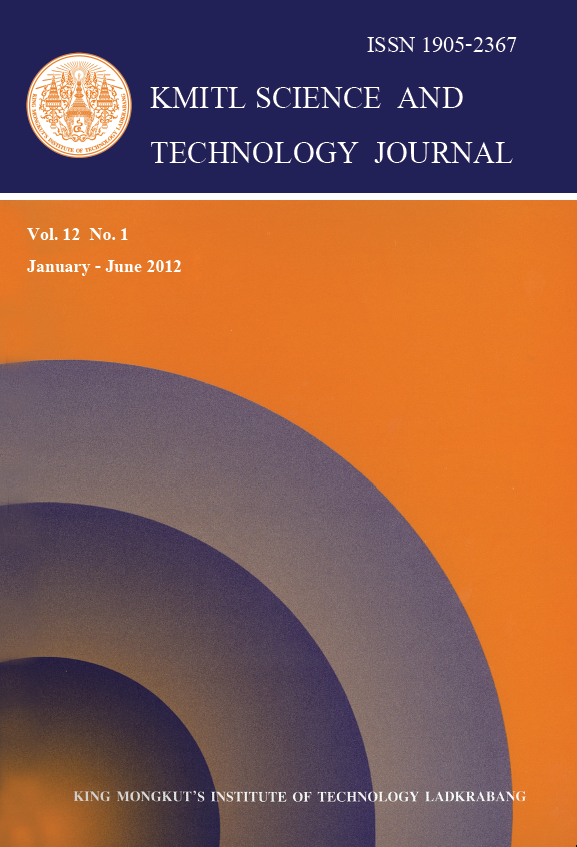Antibacterial Activity of Chrysanthemum indicum, Centella asiatica and Andrographis paniculata on Bacillus cereus and Listeria monocytogenes under Low pH Stress
Main Article Content
Abstract
Classic food preservation methods do not guarantee to inhibit Bacillus cereus and Listeria monocytogenes growth. The application of natural antibacterial agent is an alternative way to control their growth. Asia herbs, Chrysanthemum indicum, Centella asiatica, and Andrographis paniculata were used in this experiment to test their antibacterial activity under low pH stress. Their antibacterial activities of 95% ethanolic crude extracts were tested on B. cereus and L. monocytogenes 10403S under different low pH stress by agar disc diffusion method. The best antibacterial effect on both bacteria was found at low pH stress condition. Lowering pH also acts as one inhibitory effect. The result of in vitro antibacterial effect as inhibition zone at pH 7.0, 6.5,6.0, 5.5, showed that the inhibition zone diameters of C. indicum extracts were 7.62±1.18.7.87±2.35, 6.25±3.06 and 9.50±2.14 cm, while the inhibition zone diameters of C. asiatica extracts were 8.75±1.03, 8.75±2.66, 7.75±2.37 and 9.12±1.96 cm and A. paniculata extracts were 9.75±1.75, 5.87±3.52, 8.5±1.23 and 9.33±1.63 against L. monocytogenes 10403S, respectively. Under the same condition, the inhibition zone diameters of C. indicum extracts at 2.12±0.64,1.37±0.92, 0.93±0.78 and 6.00±3.25 cm, the inhibition zone diameters of C. asiatica extracts at 0.62±0.44, 2.25±0.46, 1.75±0.28 and 6.50±1.60 cm and A. paniculata extracts at 0.87±0.79,1.25±0.60, 2.00±1.65 and 6.00±1.31, respectively against B. cereus. All 95% ethanolic crude extracts showed more inhibition effect on L. monocytogenes 10403S than B.cereus. However, the promising active antibacterial compounds in all three herbs are needed to be identified. The MBCs of A. paniculata, C. asiatica and C. indicum showed 4, 16 and >32 μl/ml against B. cereus while A. paniculata and C. asiatica showed 16 and >32 μl/ml against L. monocytogenes 10403S.
Keywords: Antibacterial, Chrysanthemum indicum, Centella asiatica, Andrographis paniculata, Bacillus cereus, Listeria monocytogenes 10403S, Low pH stress, Herb
E-mail: patchaneeysr@au.edu
Article Details
Copyright Transfer Statement
The copyright of this article is transferred to Current Applied Science and Technology journal with effect if and when the article is accepted for publication. The copyright transfer covers the exclusive right to reproduce and distribute the article, including reprints, translations, photographic reproductions, electronic form (offline, online) or any other reproductions of similar nature.
The author warrants that this contribution is original and that he/she has full power to make this grant. The author signs for and accepts responsibility for releasing this material on behalf of any and all co-authors.
Here is the link for download: Copyright transfer form.pdf
References
[2] Todar, K., 2011. Todar's Online Textbook of Bacteriology Listeria monocytogenes. [on line] Available at:< http://textbookofbacteriology.net/Listeria.html>
[3] Jung, E.K., 2009. Chemical composition and antimicrobial activity of the essential oil of Chrysanthemum indicum against oral bacteria. Journal of Bacteriology and Virology, 39, 61-69.
[4] Singhamutra, S., 1992. Properties of 200 herbs. Bangkok: SO Printing House.
[5] Barker, C. and Park, S.F. 2001. Sensitization of Listeria monocytogenes to low pH, organic acids, and osmotic stress by ethanol. Applied and Environmental Microbiology, 67, 1594-1600.
[6] Ryser, E.T. and Marth, E., 1998. Growth of Listeria monocytogenes at different pH values in uncultured whey or whey cultured with Penicillium camemberti. Canadian journal of microbiology, 34, 730-734.
[7] Cotter, P.D. and Hill, C., 2003. Surviving the Acid Test: Responses of Gram-positive bacteria to low pH. Microbiology and Molecular Biology Reviews, 67, 429-453.
[8] Vigil, A .L. M., Palou, E. and Alzamora S.M., 2005. Naturally Occurring Compounds - Plant Sources. In D. P. Michael, J. N. Sofos and A.L Branen, eds. 2005. Antimicrobials in Food.Taylor & Francis Group, LLC., pp.429-452.
[9] Pitinidhipat, N. and Yasurin, P., 2012. Antibacterial Activity of Chrysanthemum indicum, Centella asiatica and Andrographis paniculata against Bacillus cereus and Listeria monocytogenes under Osmotic Stress. AU Journal of Technology, 15,4, 239-245.
[10] McMahon, M.A.S., Xu, J., Moore, J.E., Blair, I.S. and McDowell, D.A. 2007. Environmental Stress and Antibiotic Resistance in Food Related Pathogens. Applied and Environmental Microbiology, 73, 211-217.
[11] Panthi, M.P. and Chaudhary, R.P., 2006. Antibacterial Activity of some selected folklore medicinal plants from west Nepal. Scientific World, 4, 16-21.
[12] Chao, W.W. and Lin, B.F., 2010. Isolation and identification of bioactive compounds in Andrographis paniculata (Chuanxinlian). Chinese Medicine, 5, 17.


